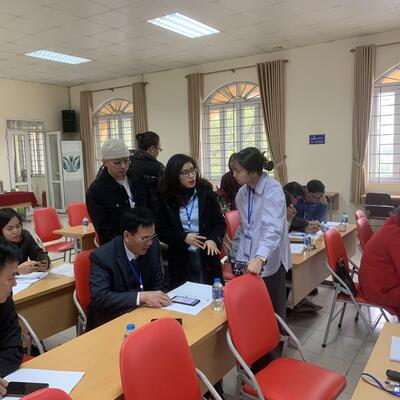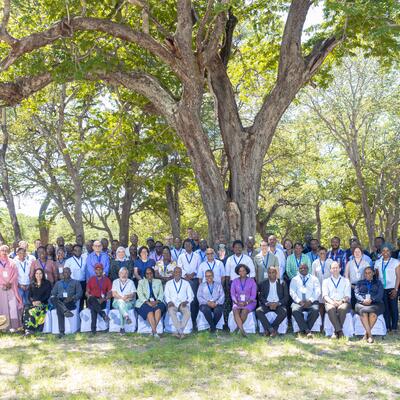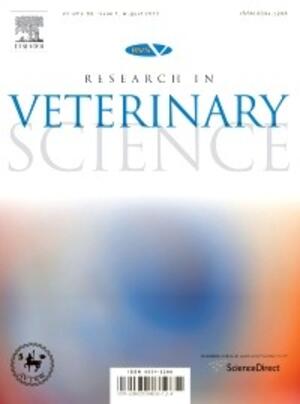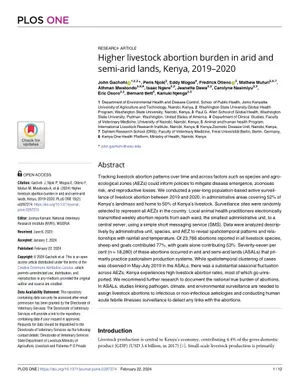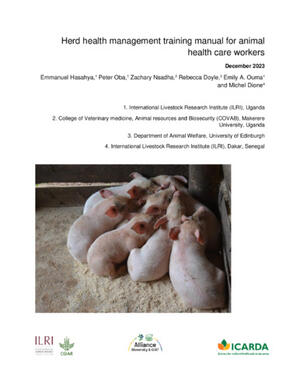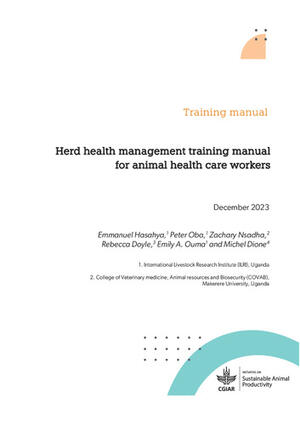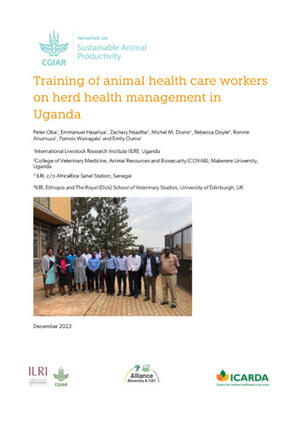
African swine fever ten years on: the lessons learned and the way forward
 A pig in northwest Vietnam (photo credit: ILRI/Hanh Le).
A pig in northwest Vietnam (photo credit: ILRI/Hanh Le).
African swine fever is a highly contagious viral disease of domestic and wild pigs that has caused serious economic and production losses in Asia, where China has seen direct economic losses of an estimated USD141 billion. This transboundary animal disease which was first detected in Africa in the 1920s, is now present in 11 countries in Asia, including most recently in Indonesia where it has killed over 40,000 pigs. It has also spread to 10 countries in Europe. The disease, which does not affect humans, can be spread by live or dead pigs (domestic or wild) and through contaminated pork products such as meat. Transmission can also occur via ticks, contaminated feed, shoes, clothing, vehicles and equipment. There is no approved vaccine against the African swine fever virus and control of the disease depends heavily on implementing strict biosecurity measures.
A little over a decade ago, scientists from the International Livestock Research Institute (ILRI), the Royal Veterinary College, the French Agricultural Research Centre for International Development (CIRAD), the Institute for Animal Health Pirbright Laboratory (now The Pirbright Institute) and the Australian Animal Health Laboratory published a review on how the spread of African swine fever can be prevented. The review ‘African swine fever: how can a global spread be prevented?’ included proposals for addressing the potential risks of the disease spreading to East and Southeast Asia and Australasia, which up to that time had not been affected by the disease. The current global spread of this disease suggests that there have been challenges in transferring the scientific risks and findings to the policymakers.
In an effort to better understand the existing knowledge gaps between research findings on managing the spread of African swine fever and actionable solutions at the international, and national levels among policymakers and farmers, ILRI’s Biosciences communications manager Ekta Patel interviewed three of the authors of that article, Dirk Pfeiffer, of City University of Hong Kong, François Roger, of CIRAD; and Linda Dixon, of the Pirbright Institute. ILRI’s deputy director for the Biosciences directorate, Dieter Schillinger, also participated in the conversation.
Ten years ago, when you published your paper, did you foresee that African swine fever would spread outside Africa into countries such as China where its presence has led to a 47% rise in pork prices and direct economic losses of an estimated USD141 billion and threatens half of the global pig population?
Dirk: I did not think African swine fever would have this level of global impact within a decade, but on reflection we should have predicted its spread. The enormous concentration of pigs in eastern Asia ultimately made the current situation inevitable and in 2017 we published a paper in the journal Veterinary Record to indicate exactly that.
Linda: For me it was always clear that Asia was at risk of Africa swine fever and its spread in the region was inevitable due to the high pig population and high percentage of small farms. However, I have been surprised by how fast it has spread.
François: Twenty years ago, when African swine fever hit Madagascar, we thought that the risk of introduction of the virus in Asia was greater due to the geographical proximity between the two continents and the potential exchange through the Indian Ocean that lies between them.
‘Bridging the communications gap between what scientists identify and what policymakers or governments take up is instrumental in implementing interventions like biosecurity measures’ — Ekta Patel
Can you tell me a little bit about any initiatives that either of you may have undertaken to see that your science and or published materials gets to the right people?
Dirk: Within the European Union, I would argue that there has been a science-policy community dealing with the African swine fever threat for at least 20 years. It was based on experience with incursions of African swine fever into southern Europe since the sixties. The key was the availability of significant research funding at the national but most importantly at the level of the European Union. The science-policy link was even further strengthened once the European Food Safety Authority was established. The situation has been very different in Southeast and East Asia, especially in China. China is a country of 1.4 billion people with over 20 provinces. It has a highly complex pork food system involving millions of small-scale farmers who are interconnected by complex trade and processing systems. I have trained Chinese government veterinarians since 2010 in a field epidemiology course, and we always brought up the African swine fever risk in the pig sector, but it will take time for these young people to get promoted to the appropriate levels in the animal health policy development hierarchy in China where they will have impact.
‘An important lesson from this current situation is that it is essential to understand the political economy in a country in some detail; based on that, one can develop good relationships with key players, so that technical expertise is not being wasted. In many, if not most countries around the world, the veterinary profession has very little political influence, and often a lot less than, for example, the medical profession, despite all of the One Health initiatives’ — Dirk Pfeiffer
François: In animal health, the important bridging agencies from science to policy or decision makers at the international level are the World Organisation for Animal Health (OIE) and the Food and Agriculture Organization of the United Nations (FAO). As an organization we have placed press releases (CIRAD press releases on African swine fever), which were shared with agencies that considered that there is a serious risk of virus introduction in China and Southeast Asia. Plenty has been done to raise awareness of the risk of spread into China. In 2000, at the International Symposium of Veterinary Epidemiology and Economics we made an oral presentation on the risk of the disease spreading into Asia due to the geographical proximity of the outbreak in Madagascar. In 2014, we made an oral presentation in Shanghai at LinkTADs within the EU-China framework (Linking Epidemiology and Laboratory Research on Transboundary Animal Disease and Zoonoses) about the risk of the disease entering into China and finally, we published the risks in the Vet Record journal. Furthermore, we worked with our regional networks to transfer the information to national governments. Unfortunately, in the case of African swine fever, these warnings were not heeded.
Currently there is no commercially available vaccine for African swine fever. Can you share what an ideal vaccine would look like to cover the various strains?
Linda: This is true. No vaccines are commercially available, but several promising experimental vaccines have been identified. Further work is needed to scale up production in a commercial environment and carry out safety and efficacy testing to meet requirements for vaccine registration.The most advanced candidates are live attenuated vaccines, usually generated by targeted gene deletions. An ideal vaccine would cause either no or mild clinical signs following immunization and the vaccine strain would not be transmissible to other animals. Protection should be at a level above the herd immunity threshold and replication of the virulent challenge virus should be eliminated or reduced to a level such that it doesn’t spread to other animals. The vaccine should induce protection against virus strains circulating in the area, and ideally it should induce cross-protection against different genotypes circulating in the wider region. To monitor the effectiveness of vaccination campaigns and confirm disease eradication, an accompanying diagnostic test should be available to distinguish vaccinated from infected animals. For vaccination in wild boars, delivery by the oral route in baits should be effective.
In some places we have a scenario where we have the ticks transmitting the disease, the wild pigs as reservoirs and there is plenty of free movement globally of pigs and their products. Then is it safe to say that we may never eradicate the disease?
Dirk: This is absolutely true, even without ticks in the mix because of the other contributing factors, such as intense pork trade networks connecting low biosecurity pig farms or a high density of wild pigs.
‘It seems unlikely that African swine fever will be eradicated.’ — Linda Dixon
François: African swine fever virus ticks are not everywhere and together with warthogs do not represent the main threat. Ticks could be reservoirs for a long time (as seen in Spain/Portugal) and in some instances no ticks have been described in eastern Europe, with only little information about ticks in China for the moment; no vectors transmitting the virus are described in Southeast Asia. The main risk of African swine fever spreading is the lack of biosecurity measures in farms, the pig and pork trades at different scales, and the presence of the wild boars. We can probably control and eliminate African swine fever in certain areas but we cannot eradicate the disease.
What additional measures or research is needed to help control the disease?
Dirk: The key is to enhance farm biosecurity and improve hygiene along the pork value chain. However, it is difficult, if not impossible, for medium, small-scale or backyard pork producers to implement the required usually very expensive measures that are needed to stop the tenacious African swine fever virus with its very high tenacity. This may mean that in countries with a high demand for pork and therefore high pig density, such as China and northern Vietnam, large to very large farms will begin to dominate the industry, as they are able to adopt the necessary biosecurity measures. It will also mean the continuing presence of the virus, since there are still likely to be regular biosecurity lapses, even on these more intensively managed farms. However, as long as the pork price is sufficiently high, in particular mega pig producing companies (raising 200,000 to one million sows) they will be able to cope with the occasional outbreak of the disease on one of their several farms. This means that in Southeast and East Asia, we will have to live with African swine fever for some time to come. All that we will be able to do is to try to contain it within that region of the world, and that means effective border controls and surveillance for early detection in countries around the world that are at risk. We also should that pig densities are not enormously high in parts of the world where high levels of farm biosecurity are not feasible due to socio-economic factors. The demand for so-called ‘fresh meat’ in Southeast and East Asian countries will remain a complicating factor, because the informal pork value chains are typically somewhat unhygienic. The availability of vaccines will not solve the problem! They will contribute to better management of the disease, but farm biosecurity still has to be improved!
‘There is need for an efficient vaccine and to improve the quality of veterinary services together with the implementation of biosecurity measures to control African swine fever especially in the low- to middle-income countries. A vaccine itself, even a very effective one, is not sufficient’ — François Roger
Dieter: From a low- and middle-income country perspective in Africa, we have a comparative advantage to address this disease because we have research facilities located in the endemic areas of the disease, which allows scientists direct access to the virus. A number of things need to continue, such as our work on epidemiology research and surveillance work and application of advanced genetic tools, such as the CRISPR-cas system, to develop next-generation vaccines. And a number of new things need to be done such as improving tests to diagnose the disease and using our genetics resources to determine if wild pigs harbour a resistant gene to this disease.
What interventions need to be put into place to prevent further spread of the disease?
François: We need strong and innovative surveillance systems that use syndromic, participatory approaches etc., based on risk modelling and that include risk mapping and assessment for African swine fever.
Dirk: We need to develop African swine fever management programs that are tailored to particular local socio-economic contexts. That is key to me, because we seem unable to stop the virus from spreading and there are too few recent examples of successful eradication to justify more optimism. This means that we need to have outbreak response policies that are socially and epidemiologically smart, instead of ‘just’ culling large numbers of pigs without being able to dispose of them in a bio-secure and environmentally sound way, which does not even stop the spread of African swine fever.
Linda: Better awareness of the disease and how to stop it spreading and help for farmers, such as compensation for any animals they lose to the disease.
Dieter: I agree with Linda. If governments compensate farmers who report sick animals, farmers would have greater incentives for quarantining sick animals rather than selling them off quickly for cash. As it has been said before, the control of African swine fever requires a combined approach consisting of strict bio-security (which is difficult for small-scale farmers), careful clinical observations, heightened surveillance, rapid detection and community education programs. Implementing such measures is a challenge for farmers, veterinarians and authorities in low- and middle-income countries.
- Visit ILRI’s African swine fever page here
- Watch ILRI principal scientist Lucilla Stienaa discuss the establishment of vaccine platform technologies that are making the African swine fever virus their first target here







